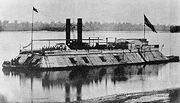
USS CARANDOLET (1862) also CARONDOLET
Built: Carandolet, Missouri
Commissioned: January 15, 1862
Service: 1862 Western Gunboat Flotilla, 1862-1865 Mississippi River Fleet
Home Port: Cairo, Illinois
Dimensions: 175' Length, 51' 2" Beam, 6' Draft
Armor: 2.5" iron Casemate, 1.25" iron Pilothouse
Armament: January, 1862 - 4x8" Smoothebores, 1x12lb Rifle, 1x30lb Rifle, 6x32lb Rifle, 1x42lb Rifle, 1x50lb Rifle. May, 1863 - 4x8" Smoothebores, 3x9" Smoothebores, 1x12lb Rifle, 1x30lb Rifle, 1x32lb Rifle, 1x42lb Rfle, 1x50lb Rifle. January, 1864 - 4x8" Smoothebores, 3x9" Smoothebores, 1x12lb Rifle, 1x30lb Rifle, 1x50lb Rifle, 2x100lb Rifle.
Engines: Stern Paddlewheel
Speed: 4 Knots
Crew: 251
Fate: Decomissioned, 1865. Sold, 1866. Swept away by flood before scrapping, 1876.
Summary
Carandolet was one of the City class riverine ironclads, or "Pook Turtles" designed by James B. Eads and Samuel Pook. Like most of the ships of her class, she was almost constantly engaged from her commissioning until the end of the war. She was named for the small Missouri port in which she was built: Carondolet, Missouri. As with most of the riverine fleet, her armament varied considerably over time. This was principally because the most advanced weapons were reserved for the Navy, and then, the Oceanic fleet. As newer weapons were made available and as the nature of their missions changed, the Union riverine ironclads were equipped with various types of weapons.
It is worth mentioning that the ship was actually known officially as USS Carondolet. However, because of the regional tendency to mispronounce the name as "CarANdolet" the spelling was often applied in period accounts, and has generally supplanted the official spelling in many sources.
Already having seen a great deal of action for her short period in service, Carandolet was one of the four principal Union warships involved in the Battle of Plum Point, and was erroneously reported rammed and sunk by the officers of the River Defense Fleet, who had confused her with USS Cincinnati. She sustained some damage, but remained afloat, and helped to secure the area after the Confederate withdrawal. She was one of the two Union vessels involved in the main action at Plum Point to be judged in sound condition enough to participate in the subsequent Battle of Memphis, where she played a lead role in routing the River Defense Fleet. In August of the same year, Carandolet moved in the company of a handful of other vessels to cut off the escape route for the recently completed Confederate ironclad, CSS Arkansas. She was roughly handled by the Arkansas, suffering thirty five casualties (a very large number for a typical ironclad warship), and forced ashore by heavy gunfire and an accurate ram. As a result of his actions in the battle with Arkansas, Carandolet's Coxswain, John G. Morrison, earned a Congressional Medal of Honor.
In 1863, Carandolet was involved in Steele's Bayou Expedition, the passing of Vicksburg, and the Battle of Grand Gulf. 1864 saw her participation in the ill fated Red River Campaign and, toward the end of the year, she helped provide gunfire support for the Union Army during the Nashville campaign. She spent the rest of her career patrolling the Cumberland.
Carandolet was decomissioned in June, 1865, and sold to private interests shortly thereafter. She was tied up and awaiting scrapping in 1876 when a flood swept her from her moorings and sent her over one hundred miles downstream where she ran aground and was lost. Carandolet was located in 1982, ironically just two days after a dredging machine had destroyed much of what remained of her wreck.